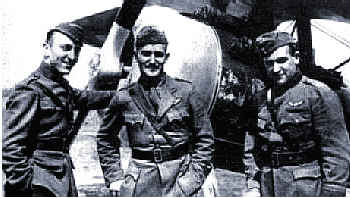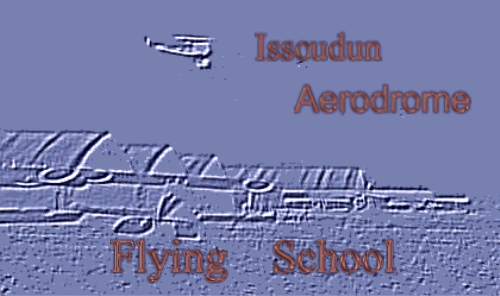
The Story of the American Expeditionary Forces
|


Distinguished Graduates: Rickenbacker, Campbell & Marr
94th Aero Squadron
The fundamental problems with discussing the aircraft used by the A.E.F. at Issoudun are both that the Army designation of the aircraft does not match the designation used by the French manufacturer, and that multiple aircraft were used at the various fields at Issoudun. The U.S. Army identified the aircraft by the area of the wing while the French manufacturer used its "type" number. Thus, one finds reference to aircraft such as the Nieuport 15M, Nieuport 18M, and the Nieuport 23M in A.E.F. records when they were indicated by theSociété Anonyme des Établissments Nieuport as the Nieuport 17, 83, and 81 respectfully
There were thirteen designated fields at Issodun, numbered 1 through 12 and 14, but only eleven were put into operation before the war ended. The specific uses of the fields changed during the course of the war as the base expanded, so that there is no absolute relationship of aircraft type to specific field throughout the war. In the early months of Issodun's operations, October 1917-February 1918, there were three fields: Rouleur (later No.1); Main Field (later No.2) and Aerobatic Field (later No.6). Field No.5 opened in February 1918 and received all the Nieuport 15M, 80 HP aircraft. Field No. 4 opened in the Spring of 1918 and received all the Nieuport 18M, 80 Hp aircraft, but on 1 July 1918 that field became an extension and landing field associated with Fields Nos. 5 and 6 which received the Nieuport 15M, 80 HP and 15M, 120 HP for cross-country, spiral and altitude training. Field No.9 received all the Nieuport 18M, 80 HP aircraft that were transferred from the now decommissioned Field No.4
The pursuit-training program was in two parts. The first fourteen hours were accomplished at Fields Nos. 1 (Morane rouleurs); 2 (Nieuport 23M dual control and solo aircraft) and 4 (Nieuport 18M, 80 HP aircraft) until I July 1918 when this training activity was transferred to Field No.9
After fourteen hours of instruction the student pilot was either sent on to advanced pursuit training (30 hours) or to observation or bomber training. The advanced pursuit course was accomplished on Fields Nos. 5 and 6, which included Field 4 as an extension and landing field. The aircraft used for advanced training on those fields were the Nieuport 15M, 80 HP and the 15M, 120 HP.

The Nieuport 83 [18] Used for Gunnery Training at Issodun
Toward the end of 1918, Field 10 became a training field for DH-4 pilots who were to join observation squadrons. Fields 11 and 12 were not put into operation (Field 12 was intended to become a field in which Avro aircraft were to be used and training was to be based on the British Gosport system. Due to a lack of aircraft this plan was never implemented.
Field 14 was an aerial gunnery field in which Nieuport 24 aircraft were used in a mode in which the student pilot fired his machine gun at a ground target.
The student's progression through these fields was typically as follows:
- 1. Start at Field 1
- 2. Walk over to Field 2
- 3. Progress to Field 3
- 4. Go to Field 9 for introduction to the Nieuport 18M (Graduates either proceeded to Field 10 for 2-seater training or to Field 4 for pursuit training
- 5. Field 4 for spiral turns
- 6. Field 5 for taxiing, taking off, and landing and wing slips
- 7. Field 6 for advanced acrobatics
- 8. Field 9 for training with Nieuport 15M with 80 HP engine
- 9. Field 7 for training with Nieuport 15M with 120 HP engine
- 10. Field 8 for aerial combat training
- 11. Field 14 for machine gun training
Aircraft used at each field were as follows:
- Field 1: Morane rouleurs (preliminary training)
- Field 2: Nieuport 23M, 80 HP dual control aircraft
- Field 3: Nieuport 23M, 80 HP single seat (solo) aircraft
- Field 4: Nieuport 18M, 80 HP (Feb-July 1918 only. After that part of Fields 5 & 6).
- Field 5: Nieuport 15M, 80 HP and 120 HP aircraft with instruction in taxiing, taking off, and landing
- Field 6: Nieuport 15M with 120 HP engine with instruction in advanced acrobatics
- Field 7: Formation flying and patrol tactics using 120 HP Nieuport 15M aircraft
- Field 8: Introduction to Aerial Combat using 120 HP Nieuport 15M aircraft
- Field 9: Nieuport 18M, 80 HP from 1 July 1918 to the end of the war
- Field 10: DH-4 aircraft for observation pilot training (opened late in the war)
- Fields 11 and 12: Not put into operation.
- Field 14: Machine gun training using Nieuport 24 aircraft
Operating the 3rd Aviation Instruction Center required a large number of organizations. Serving at Issoudun were the following U.S. Aero Squadrons: 10th, 21st, 26th, 30th, 31st, 32nd, 33rd, 35th, 37th, 43rd, 101st, 149th, 158th, 173rd, 257, 369th, 372nd, 374th, 640th, 641st, 642nd, 644th, 801st, 802nd, and 1104th.
|
|
:
Sources and Thanks: Author and GWS member Dwight Messimer much of the material for this article. Glenn Hyatt sent the photo of the aces.
MH
|
To find other Doughboy Features visit our
Directory Page
|
For Great War Society
Membership Information

Click on Icon |
For further information on the events of 1914-1918
visit the homepage of
The Great War Society
|
Additions and comments on these pages may be directed to:
Michael E. Hanlon
(medwardh@hotmail.com) regarding content,
or toMike Iavarone (mikei01@execpc.com)
regarding form and function.
Original artwork & copy; © 1998-2000, The
Great War Society
|





